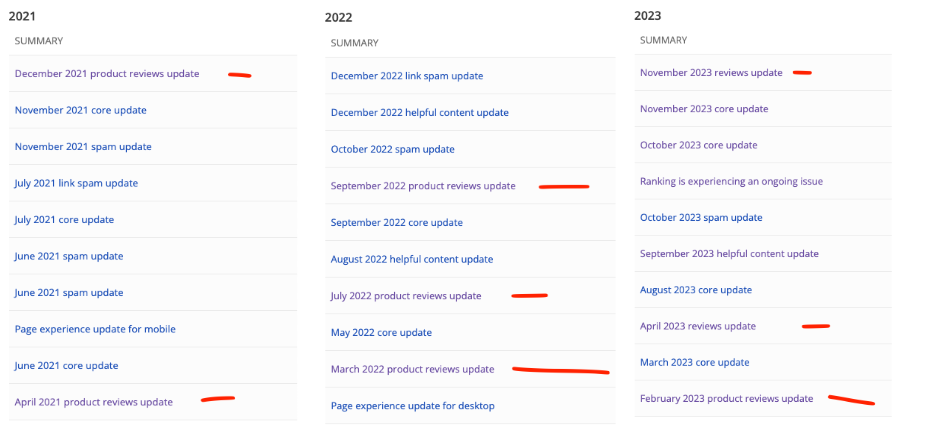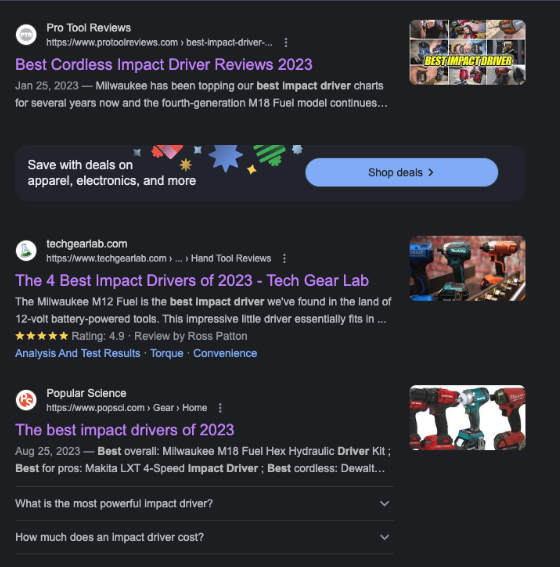
Navigating the World of Review Content: Insights from an SEO Specialist

Get helpful updates in your inbox
In a recent webinar, SEO specialist Zachary Ashmun teaches viewers about the history and purpose of something that affects us all: Google Review Updates. In this article, you’ll learn how to identify current trends within search results for review-style content and understand best practices for creating review-style content.
Understanding the History and Purpose of Google Review Updates
Did you know that in the past three years alone, Google has rolled out approximately eight updates specifically targeting review content?
That’s a testament to how critical high-quality reviews are in the search landscape. For those of us in the digital realm, staying abreast of these changes isn’t just important—it’s essential.

Google’s review updates are driven by a commitment to match their algorithm with the core concepts in the Search Quality Rater Guidelines, emphasizing the E-A-T (Expertise, Authoritativeness, Trustworthiness) and YMYL (Your Money or Your Life) principles.
There are an overwhelming number of articles online informing which products to buy for everything in your life. It is Google’s job to provide you with the most consistently reliable information possible to ensure you are protected from harmful opinions or suggestions.
Websites that align with these guidelines are more likely to gain favorable rankings in Google’s search results. Notably, Google’s updates consistently strive to present the most reliable and trustworthy sources, with a focus on E-A-T and YMYL topics.
Zach recommends keeping tabs on the Google Search Status Dashboard and delving into the Google Search Engine Journal’s comprehensive history of Google algorithm updates for those who want to stay ahead of the curve.
Who’s Winning The Review Game?
To put theory into practice, Zach conducted a live experiment with us, analyzing the search results for “best impact driver.” The findings were clear: big brands, large companies, YouTube channels, and forums are dominating the rankings. This isn’t by chance—it’s a reflection of Google’s preference for content sources that are seen as reliable and authoritative.

It’s not just written content that’s making waves. Zach emphasized the growing importance of video content, with YouTube emerging as a powerhouse in the search engine world. For website owners, this means one thing: diversify your content strategy to include video if you want to stay competitive.
Crafting Content That Ranks: Strategies for Success
Establishing a methodology for reviewing content is crucial for EAT in Google’s search algorithms for several reasons:
- Consistency in Evaluation: A well-defined methodology ensures that content is evaluated consistently. This is particularly important for EAT because it helps maintain uniform standards for assessing the expertise, authoritativeness, and trustworthiness of various types of content.
- Algorithmic Accuracy: Google’s algorithms rely on data-driven decision-making. By having a clear methodology, Google can program its algorithms to accurately assess EAT factors, improving the accuracy of search results and reducing the chances of misinformation or low-quality content appearing prominently.
- User Trust: Users trust Google to provide reliable and relevant information. By having a transparent methodology for EAT evaluations, Google can build and maintain user trust by demonstrating a commitment to delivering high-quality and trustworthy content in search results.
- Mitigating Bias: A well-established methodology can help mitigate potential bias in EAT evaluations. It ensures that content is evaluated based on objective criteria rather than subjective judgments, reducing the risk of favoring or disfavoring certain viewpoints or sources.
- Continuous Improvement: With a methodology in place, Google can regularly review and refine its evaluation process. This allows the company to adapt to changing content trends and evolving user expectations, ensuring that the search engine remains effective in surfacing high-quality content.
- Feedback Loop: Establishing a methodology also facilitates a feedback loop between Google and content creators. When the criteria for EAT evaluations are clear, content creators can better understand how to improve their content to meet Google’s standards, ultimately raising the overall quality of content on the internet
There are two primary documents Zach urges website owners to refer to when creating review content:
- How to Write High-Quality Reviews: This is a resource directly from Google and has been updated within the last year to encompass all reviews – not just product reviews. Movies, games, products, services, etc. are all included in this document.
- Creating Helpful, Reliable, People-First Content: This is another Google resource that can guide any content published online for the purpose of ranking in organic search. A primary focus of this article is EEAT and how it relates to your content and website as a whole.
These resources go hand in hand for creating review content. Zach highly recommends publishers read through both resources before writing content to better understand what Google is looking for in today’s search landscape.
He pointed to Livewire Magazine as a prime example of an authoritative site that provides comprehensive information about its team and editorial process.
Branding Guidelines for Ranking Higher for Review Content
Building trust with users is paramount, and Zach shared strategies to increase a website’s digital footprint, such as engaging in forums, creating video content, and guest posting on platforms like LinkedIn.
EEAT Strategy
Some examples of high quality EAT strategies come from investopedia.com and lifewire.com. These two About pages give an accurate picture of what a very successful EAT strategy looks like. We highly recommend that you duplicate their strategies on your own site to promote your credibility, reliability, and authenticity.
Branding Awareness
Google had to ask themselves, “How do we consistently provide reliable, credible, and human-created content for the majority of keywords?” The answer to this question was the following: promote large companies/brands that have to perform perfectly to ensure a positive image. Or promote forum based content that is 99% of the time human/user generated content that is, generally, helpful.
Increasing Digital Footprint
A large aspect of Google’s Core Updates and Helpful Content Updates is the topic of authority. You and the team that make up your website should be well-known within the community you are targeting. This means that you cannot simply exist only on your website. You must provide outside signals, pointing towards your site, that help demonstrate that you are a reliable source within that particular niche.
On-Page Strategies for Review-Centric Content
When it comes to on-page strategies, Zach’s recommendations were gold. Speak from a first-person perspective, use high-quality images and videos, and don’t forget about schema markup—it’s a secret weapon to help search engines understand your content better.’
- Ensure you have a strong EAT strategy: Zach recommends reading through the resources linked above where Google, in multiple places, describes the quality of EAT you should have on your website. From there, place yourself in the shoes of the user. Ask yourself, “What would make me trust this person’s opinion on this topic?” Whatever that answer is, make sure you have it on the page.
- Utilize multiple forms of schema: Product, Pros & Cons, Review, Rating, Person, Video, and FAQ schemas are all great additions to any review page. This greatly enhances Google’s understanding of your article and should improve your overall visibility. You can generate this schema from Yoast or Rankmath plugins, or utilize the schema generator I have linked below.
- Use high-quality images: Again, put yourself in the shoes of the buyer. Let’s use the example of reviewing a product. They will want to see your product in use, the features it has, the box it comes in, and the overall experience of owning it. High-quality images are a must whenever you are creating review content.
- Use high-quality video: Similar to the suggestion above, a video of someone using the product for its intended purpose is a great way to provide a unique perspective on the review of the topic. Humix, Flickify, or other Ezoic video tools are great ways to get started with video.
- Speak from a first-person point of view: This goes back to the EAT section. Write as if you are recommending the topic (product, movie review, best diners, etc) to a friend. Utilizing pronouns such as I, me, or we in your sentences can greatly improve the personality of your review.
- Cover the topic holistically: (Using the product example, again) Don’t just simply review the product, answer any questions related to the product that you can think of as well. When people are spending money on a product, they want to have researched it thoroughly and extensively. Zach recommended that publishers create a holistic experience for visitors to become the one-stop shop for all of product-related questions.
Conclusion
The presentation wrapped up with a Q&A session, where Zach tackled questions on the impact of affiliate links on rankings and the use of images from other websites. He also shared a pro tip: use tools like ChatGPT to create schema markup and be selective with your visual content to avoid giving your competitors an unintended boost.
In conclusion, Zach’s presentation was a treasure trove of insights for anyone looking to master the art of review content in today’s SEO landscape. Navigating the complexities of SEO requires a deep understanding of Google’s evolving guidelines and a strategic approach to content creation. By focusing on E-A-T principles, enhancing brand authority, and utilizing a variety of content formats, websites can improve their chances of ranking higher in search results.
If you are an Ezoic publisher, you can watch a recording of Zach’s webinar here. Weekly Walkthrough webinars happen every Wednesday, check out past recordings and register for future events here.

Sarah is a social media expert and successful brand marketer. She has experience growing brands and content across multiple different platforms and is always on the cutting edge of emerging social platform and internet culture trends.
Featured Content
Checkout this popular and trending content

Ranking In Universal Search Results: Video Is The Secret
See how Flickify can become the ultimate SEO hack for sites missing out on rankings because of a lack of video.
Announcement

Ezoic Edge: The Fastest Way To Load Pages. Period.
Ezoic announces an industry-first edge content delivery network for websites and creators; bringing the fastest pages on the web to Ezoic publishers.
Launch

Ezoic Unveils New Enterprise Program: Empowering Creators to Scale and Succeed
Ezoic recently announced a higher level designed for publishers that have reached that ultimate stage of growth. See what it means for Ezoic users.
Announcement
